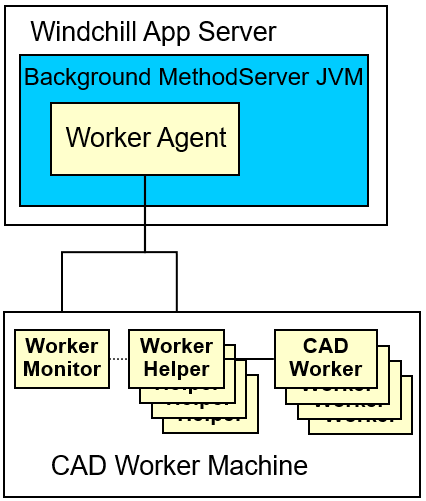Overview of Monitor, Helper and Worker
The functions of the Monitor, Helper, and Worker are outlined below.
Overview of Monitor
• The Monitor, also known as the workermonitor process, is the first process executed on the worker machine by the Worker Agent, also known as the server, and communicates directly with the Worker Agent.
• Using the Monitor, the server can perform the following actions:
◦ Communicate with the worker machine, even when the Helper, and Worker are not running, and start a new worker.
◦ View log files on the worker machine for the Monitor, Helper, and Worker, even when the worker itself fails to start.
• Use a single Monitor process to start multiple instances of a single worker definition:

• Workers that are enabled for file synchronization are restricted to a single-worker instance per worker definition due to the unique configuration that each requires.
Overview of Helper
• The Helper, also known as workerhelper, acts as a middleman to handle the communication between the Worker Agent and the Worker process.
• The Helper provides a local process running on the worker machine that can control the worker process more effectively.
• A single Helper manages only one Worker.
• The Helper log file provides information, including the following:
◦ Whether the Worker started successfully or why it failed to start.
◦ How the publish job is proceeding, and the overall status of the Worker.
• The Helper can implement timeouts locally on the Worker machine. If a problem occurs or the Worker needs to be shut down, the Helper ensures that the worker is shut down completely and cleans up any remaining processes or files.
The workerhelper does not guarantee a full recovery from errors on the CAD worker. In some cases, you might need to reboot or to manually end processes. |
Overview of Worker
• The Worker performs the actions required to process the publishing, printing ,or Interference Job that is sent through the Worker Agent by the Helper. These actions are defined in the Job PAJ file that are sent through its configured Common File-system.
• The Worker is typically written using the APIs of the application used to create the processed files, for example, the Creo TOOLKIT APIs for publishing Creo CAD files.
• The Worker log file shows the conversion process:
◦ If a publish job fails, the Worker log file contains debugging information for the conversion.
◦ When publishing, you can set the debug logging options to specify the recorded information in the log file. Use the debug options text file in the specified setup directory during configuration.
You can configure the TCIPIP Connection Keepalive timeout value of the Worker as specified in the Article CS297388.